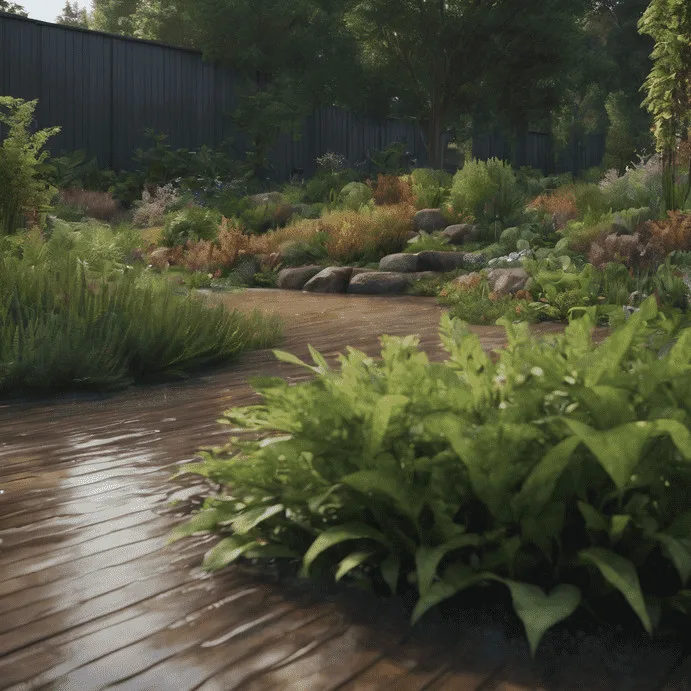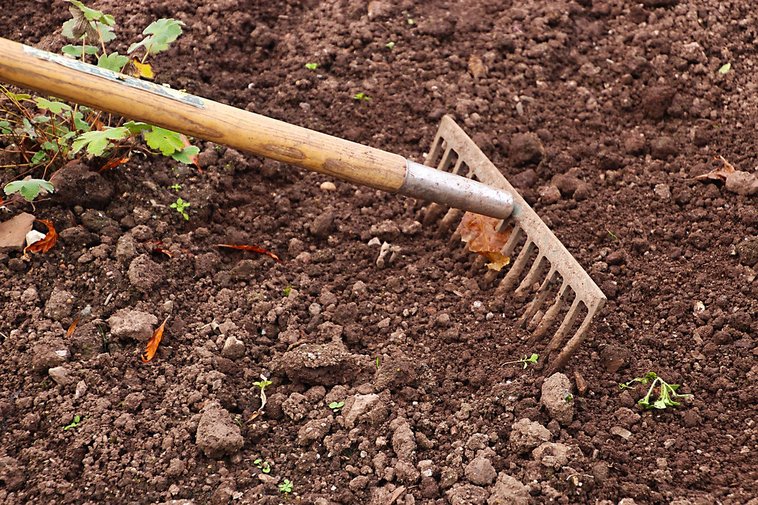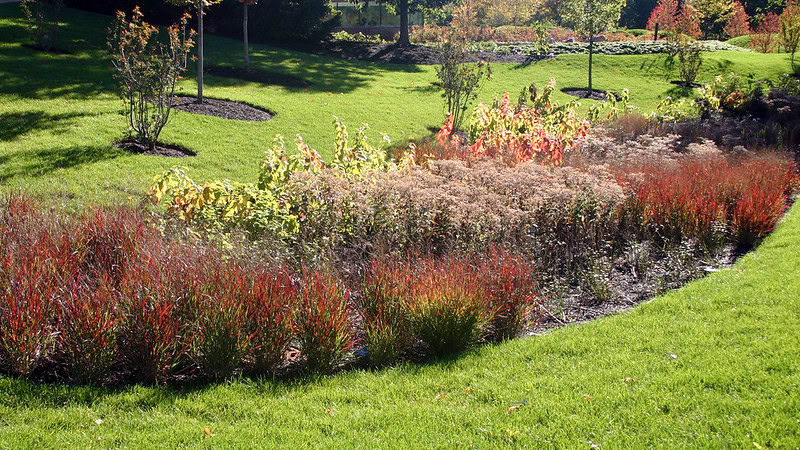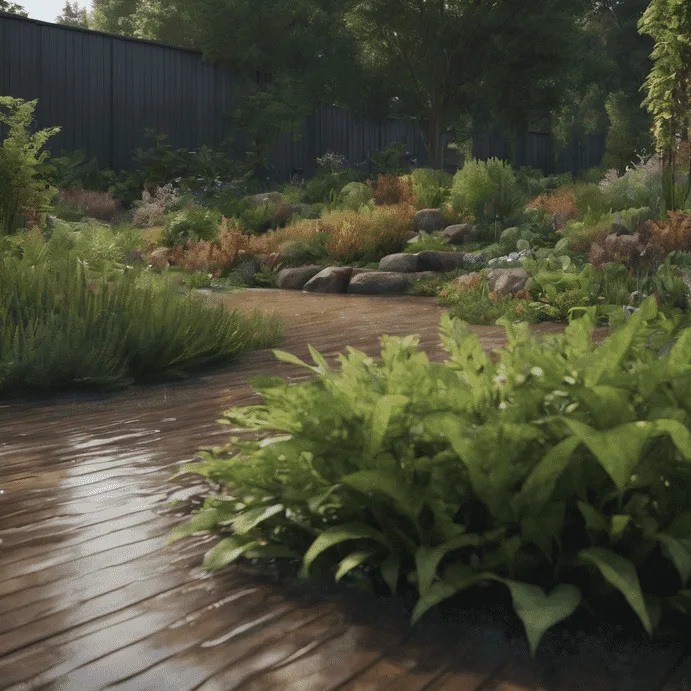A rain garden is a designed landscape feature that helps manage stormwater runoff, promote water conservation, and reduce the risk of water pollution.
This sustainable landscaping approach uses plants and soil to absorb, filter, and manage rainwater from roofs, driveways, and other surfaces.
In this blog post, we will guide you through the process of designing and creating your very own rain garden, explore the numerous benefits it offers, and suggest some suitable plant options.
So, let’s dive in and learn how to make a simple rain garden!

Designing Your Rain Garden
Choosing the Right Location
The first step in creating a rain garden is selecting an appropriate location. Ideally, the garden should be situated in a low-lying area where water tends to accumulate during heavy rains.
This can be near a downspout, at the base of a slope, or in a depressed section of your yard. Ensure that the garden is at least 10 feet away from your home’s foundation to prevent moisture-related issues.
Determining the Size
The size of your rain garden will depend on various factors such as the available space, the amount of rainfall in your area, and the type of soil you have.
A general rule of thumb is to aim for a rain garden that covers about 10% of the total area draining into it. For example, if you have 1000 square feet of roof area draining into the garden, it should ideally be around 100 square feet in size.

Assessing Soil Conditions
Understanding your soil type is crucial for the success of your rain garden. Conduct a simple soil test to determine if your soil has good drainage or tends to become waterlogged.
Dig a hole about 12 inches deep and fill it with water. If the water drains within 24 hours, you have well-drained soil.
If it takes longer or does not drain at all, you may need to amend the soil to improve drainage. Adding compost or sand can help enhance drainage in heavy clay soils while adding organic matter can increase water retention in sandy soils.
Choosing the Right Plants
Now comes the fun part: selecting the plants for your rain garden! Native plants are excellent choices as they are well-adapted to the local climate and require less maintenance.
They also provide food and habitat for native pollinators and birds. Consider incorporating a mix of grasses, wildflowers, shrubs, and small trees to create a diverse and visually appealing rain garden.
Benefits of a Rain Garden
Managing Stormwater Runoff
One of the primary benefits of a rain garden is its ability to effectively manage stormwater runoff. By capturing rainwater from rooftops, driveways, and other impervious surfaces, a rain garden allows the water to slowly infiltrate into the ground.
This process filters out pollutants and reduces the amount of water entering storm drains and nearby water bodies, thus alleviating issues such as flooding and erosion.
Promoting Water Conservation
Rain gardens also play a significant role in water conservation. Instead of allowing rainwater to flow into storm drains and be lost to the sewer system, rain gardens enable the water to replenish the groundwater table.
This, in turn, helps maintain adequate water levels, especially during dry periods, reducing the need for irrigation.
Enhancing Biodiversity
By creating a rain garden, you are providing a welcoming habitat for a range of plants, insects, birds, and other wildlife.
Native plants attract a variety of pollinators, supporting the crucial role they play in the ecosystem. Additionally, the garden’s diverse vegetation can act as a haven for beneficial insects that help control pests naturally, reducing the need for harmful pesticides.
Adding Beauty and Value to Your Landscape
Aside from the environmental benefits, rain gardens also contribute to the aesthetic appeal of your landscape.
With their vibrant colors, unique textures, and ever-changing beauty throughout the seasons, these gardens can be a visual delight.
Moreover, a well-designed rain garden can add value to your property, making it more attractive to potential buyers.

Suitable Plants for Your Rain Garden
Grasses
- Switchgrass: With its tall, graceful structure and beautiful seed heads, switchgrass (Panicum virgatum) is an excellent choice. It thrives in a variety of soil types, requires minimal maintenance, and provides food and shelter for wildlife.
- Sedges: Sedges, such as Carex spp., are incredibly versatile and can tolerate a wide range of soil and moisture conditions. They add texture and interest to the rain garden with their grass-like leaves and delicate seed heads.
Wildflowers
- Purple Coneflower: Known for its vibrant purple petals and prominent cone-shaped centers, the purple coneflower (Echinacea Purpurea) attracts pollinators and adds a splash of color to your rain garden.
- Black-eyed Susan: The black-eyed Susan (Rudbeckia hirta) is a classic wildflower with golden-yellow petals and a dark brown center. This low-maintenance perennial brightens up any rain garden and serves as a valuable nectar source for bees and butterflies.
Shrubs and Trees
- Red-Twig Dogwood: The red-twig dogwood (Cornus Sericea) is a striking shrub that adds visual interest to a rain garden year-round. Its vibrant red branches provide a pop of color during the winter months and serve as a nesting site for birds.
- River Birch: River birch (Betula nigra) is an attractive tree with peeling bark that adds a unique texture to the rain garden. It thrives in wetter conditions and provides shade, making it a sought-after choice for wildlife.
Final thought
In conclusion, creating a rain garden is a rewarding endeavor that offers numerous benefits for both you and the environment.
By following the steps outlined in this article, you can design and build your very own rain garden. Not only will it help manage stormwater runoff and promote water conservation, but it will also attract a myriad of wildlife and enhance the overall beauty of your landscape.
So, why not embark on this eco-friendly journey and make a positive impact right in your backyard? Happy gardening!
FAQs
What is another name for a rain garden?
Another name for a rain garden is a “stormwater garden” or “bio-retention area.”
Where is the best place for a rain garden?
The best place for a rain garden is in an area that receives runoff from impervious surfaces like roofs, driveways, or walkways. It should be strategically located to capture and manage stormwater runoff effectively.
What is the role of a rain garden in water recharge?
The rain garden plays a crucial role in water recharge by allowing stormwater to infiltrate into the soil. The plants and soil in the rain garden absorb and filter rainwater, promoting groundwater recharge.
This process helps maintain a sustainable water balance in the environment, reducing the risk of flooding and enhancing overall water quality.
Rain gardens contribute to the natural replenishment of aquifers and help mitigate the impacts of urbanization on water resources.

